| locale | ||
| registry | ||
| screenshots | ||
| system | ||
| textures | ||
| init.lua | ||
| LICENSE.txt | ||
| mod.conf | ||
| README.md | ||
| screenshot.png | ||
“Unified Hammers” adds various hammers that can be used to crush nodes.
Default usage
The mod registers various hammers. Those hammers can be crafted from sticks and their respective material. Different material hammers can be used different times before they break.
Crafting the hammers needs two sticks and two of the material as shown in the image above. Crafting is then done very similar to the other tools.
The recipe shape is always the same, just interchange the head material. If the moreores mod is installed and loaded hammers can be crafted from the mod’s ores in the same way as shown above.
Default functionality
The hammers added by this mod can be used to crush material into “softer” material.
The three default sandstone types can be crushed into the corresponding three default sand types, too.
Durability
The durability is based on personal opinion.
| Hammer Material | Mod | Durability (uses) |
|---|---|---|
| Wood | default |
30 |
| Stone | default |
70 |
| Gold | default |
100 |
| Bronze | default |
150 |
| Steel | default |
200 |
| Silver | moreores |
250 |
| Diamond | default |
300 |
| Mese | default |
350 |
| Obsidian | default |
400 |
| Mithril | moreores |
450 |
Feel free to suggest changes.
API usage
The Unified Hammers API can be used by calling the uniham.register_hammer function. This function takes two parameters, the ID and the definition table.
uniham.register_hammer('my_cool_id', {
name = 'My Cool Hammer',
head = {
texture = 'mymod_my_cool_head_base_texture.png',
opacity = 51.2
}
--- Alternative to `head`, see description below
-- texture = 'mymod_my_cool_hammer_texture.png',
craft = 'mymod:my_cool_item',
uses = 200
})
This registers a hammer with the name “My Cool Hammer” that has the ID mymod:my_cool_id. The head base texture is mymod_my_cool_texture.png with the embossing effect being 20% visible (51.2) and the texture is automatically masked to form a hammer head.
If instead of head the value texture is provided then the automatic texture generation is disabled and the hammer will get the texture defined by the texture value. If both values are added then the texture value is given precedence.
The hammer is crafted like the provided hammers with two sticks and two of the items provided for craft. Alternative: When providing a recipe table instead of an item ID then the recipe table is used for registering the crafting recipe for the hammer (the output value gets automatically set by the API and can be omitted).
uses defines how often the hammer can be used. The value also gets stored in the tool’s definition as _uniham.uses that can be used by a custom on_use function for example
The registration table allows another, absolutely optional, parameter on_use. This parameter has to be a function being, well, an on_use function as defined by the Minetest API. This overrides the built-in on_use function that replaces the nodes as described. Custom on_use function have to handle wear and itemstack returning.


